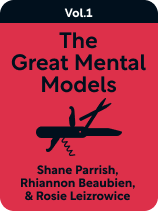

This article is an excerpt from the Shortform book guide to "The Great Mental Models Volume 1" by Shane Parrish and Rhiannon Beaubien. Shortform has the world's best summaries and analyses of books you should be reading.
Like this article? Sign up for a free trial here.
What’s first-principles thinking? How can it help you think for yourself and more effectively?
In The Great Mental Models Volume 1, Shane Parrish and Rhiannon Beaubien discuss how and why to think with mental models. Thinking from first principles is one of their foundational models.
Read more to learn what first-principles thinking is and how to apply it in your own life.
First Principles
When examining any problem, start with the basic facts or bedrock assumptions of the discipline or field. These are called first principles—in other words, the fundamentals of the discipline or domain. For instance, the first principles of conversation involve active listening and respect for your conversational partner. By thinking from first principles, you ensure that anything you do is built upon a solid, proven foundation.
(Shortform note: One notable attempt to derive first principles is the linguistic theory of a “Universal Grammar,” most associated with Noam Chomsky. This theory sought to find the basic, bedrock grammatical rules that, in theory, are common to all languages. While it found early success, UG has come under criticism in recent years, with scholars noting the ambiguity and confusion surrounding what the proposed basic principles are and how they work. This suggests that searching for universal principles is difficult, and perhaps impossible—so in practice, focus on finding what works in your given situation.)
According to the authors, starting from the fundamentals enables you to think for yourself. Typically, we see the world through a layer of inherited ideas and assumptions that influences how we think. But, if you start from the bedrock facts, you can devise solutions that are independent of cultural conventions. This is the difference between knowing how to follow established rules and knowing enough to improvise your own solutions—the difference between a cook who can only follow recipes and a chef who understands how to create delicious food without directions.
| First Principles in Chess In The Art of Learning, Josh Waitzkin explains how he started his journey to chess mastery by studying the basic elements of the skill—in other words, the first principles. In chess, you learn first principles by studying simple situations that demonstrate the core capabilities of each piece. From each situation, you learn what each piece can and can’t do, as well as how they relate to one another. For instance, Waitzkin first studied King-Pawn versus King. In this situation, the objective is to understand how you can trap the lone king with your king and pawn. By practicing the situation diligently, you learn the strengths and limitations of each piece, and you discern the principles that govern the interaction. Once you understand that principle, you can move on to a different elemental situation. Further, Waitzkin explains that understanding these underlying principles gives you a deeper understanding of chess strategy. While a player who simply memorizes moves will fail when his rote strategy falls apart, a player who understands principles can recognize them at play and adapt his strategy on the fly. Fundamentals enable you to see what’s going on beneath the surface and adapt. |
Applying this model: While there’s not always an easy way to find first principles, the authors recommend that you start by questioning what you believe to be fundamental. Often, you’ll find that supposedly bedrock principles are just conventions or unexamined beliefs. Keep questioning these, and you’ll eventually reach a handful of concepts that you can’t reduce any further. For instance, the fundamentals of cooking are four basic elements: salt, fat, acid, and heat. Knowing these, you can apply them by experimenting to figure out how they relate and suggest secondary and tertiary principles.
(Shortform note: Some fields and skills, such as physics, chess, or classical music, have established fundamentals. For instance, chess fundamentals include “control the center” and “tie up two opposing pieces with one.” None of these are obvious at first glance, so don’t stress about finding first principles right away—it can take many people and many years to establish truly bedrock, reliable fundamentals.)

———End of Preview———
Like what you just read? Read the rest of the world's best book summary and analysis of Shane Parrish and Rhiannon Beaubien's "The Great Mental Models Volume 1" at Shortform.
Here's what you'll find in our full The Great Mental Models Volume 1 summary:
- What mental models are and how they work
- How to make better decisions by using mental models
- How to use your imagination to evaluate your choices






